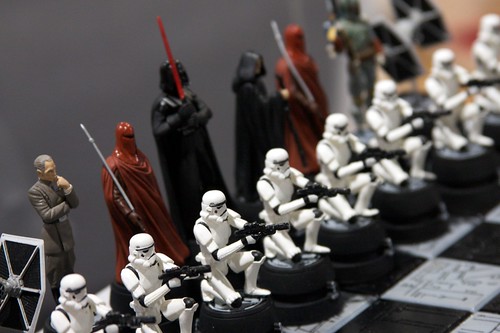The Aesthetics of Games
It might not seem like it but aesthetics–art, beauty and visual elements—are part of every game from the symmetry of the tic-tac-toe game space to the clever little Monopoly pieces and all the way to the cinematic detail of a video game like Red Dead Redemption with its panoramic views of the American Wild West. Regardless of the game, aesthetics play an important role. Chess pieces require certain aesthetics to distinguish a bishop from a pawn, a knight from a queen and even to tell one side (white) from the other (black). But beyond even those aesthetics, Chess pieces have become a constant source of inspirations for artists who create beautifully handmade pieces or craft an entire board of dinosaurs or Star Wars characters to assume the roles of pawn, knight, queen and others.

Star Wars Chess Pieces
Ignoring aesthetics in the design and creation of a game or the use of gamification techniques reduces the overall experience of the players. The space in which the game is played becomes boring without aesthetics. Rich visuals, simple contrasts or colorful backdrops create an immersive environment that contributes to the overall game experience. The aesthetics help the player become caught up in the game experience. The artistry and design becomes compelling. Even simple game elements like receiving a badge in Foursquare or observing the curve of your last run with NikePlus require attention to detail. Too often educational games and simulations disregard aesthetics this can cause an experience to be less engaging and less compelling. It is not that good aesthetics will make a bad experience great, they won’t. But they can lift a good experience into a great experience.

Foursquare Badges
However, don’t confuse aesthetics with realism. A game or simulation doesn’t need to have photorealistic images to be visually appealing. Games like Farmville have simplistic and non-realistic graphics but, nevertheless, those graphics add to the game play and dynamics of the experience. It is not the realism of the graphics but the use of the graphics within the game that make them so powerful.

SimCity Power Plant Billowing Smoke
The key is that the graphics both add to the story of the game and convey meaning. When you decide to build an oil burning power plant in SimCity, the tiny plant puffs grayish black oil smoke into the atmosphere just as you would expect. This is a small but critical aesthetic that adds to the experience of playing SimCity and supports the underlying story of building a city. In Civilization V, the animation of the farmers cultivating the land in unison creates a sense of people at work which again supports the story.
The game pieces in Bejeweled or Tetris convey meaning visually themselves. You either have the jewels you need in a row or you have a piece that you must fit into a growing floor of blocks. In those games, the visuals are how information is conveyed. In other games, first-person shooters or adventure games visuals convey information to the player within the game interface but not as part of the action of the game. These include meters indicating the level of health of a player or a map image pinpointing his or her location within the game. In some games the color of the player changes if they are evoking a special power such as turning red at times of invincibility.
Posted in: Content Guide
Leave a Comment (0) ↓